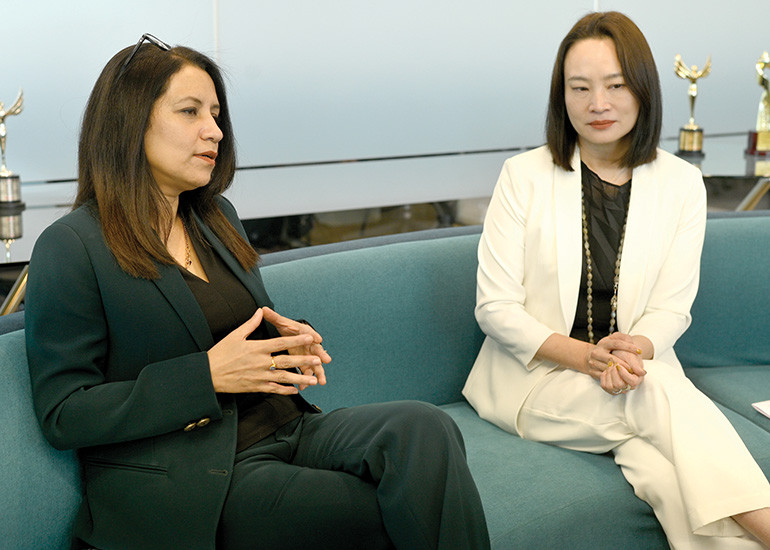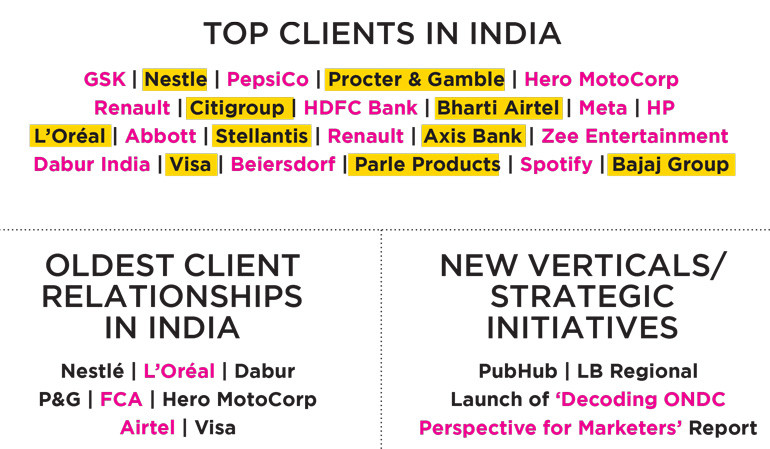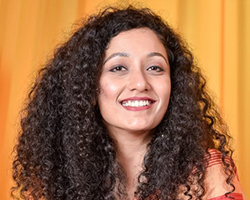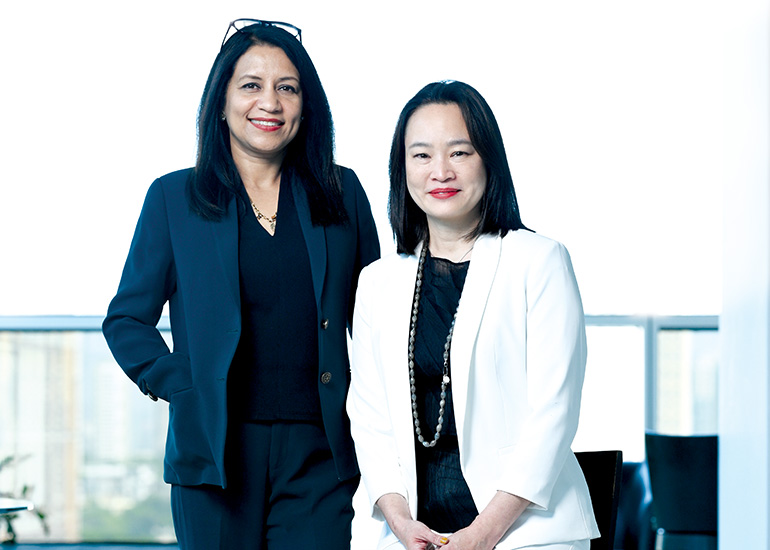Publicis Groupe is on the crest of a wave at this point. The 500 million euros bonus that the company is believed to have doled out to its employees after the second consecutive year of over 10% growth is indicative enough. In fact, Publicis Groupe topped the R3 New Business League for 2022 with 2,249 wins and $804m in increased revenue, almost double the New Business increase of second-placed WPP. Publicis Milan has repeatedly swept the number one spot in the WARC creative agency ranking. Closer home, Leo Burnett and Zenith have been the brighter stars.
The Company’s data-led investments - Epsilon and Sapient - seem to be paying off handsomely as the global and APAC demands for tech, data, commerce, performance, and all things Digital soar.
Against this backdrop of a “very strong 2022,” globally as well as in APAC, Jane Lin-Baden - CEO, Publicis Groupe, APAC, and Anupriya Acharya - CEO, Publicis Groupe, South Asia, tell us what went into the making of a stellar year, during the former’s recent visit to India.
“We had a very strong 2022, globally, as well as in APAC, even if we consider the lockdowns in China. 2022 was also the year of the strongest new business momentum for us. We have three agencies, all ranked as number one in terms of new business wins,” says an elated Jane.
Commenting on the factors that worked in favour of the group, she adds, “One, we are seeing that clients are coming to us for a more elaborative service. The ability to put different services together for them as one team has helped a lot because they see that as a benefit. Second, we have been investing in specialty areas, including tech, data, commerce, and performance. That pays off during the pitch. Clients see that we also have specialties in addition to the other services, and that has been very helpful.”
With some of the biggest advertisers like Abbott, Meta, Standard Chartered, Nestle, PepsiCo and many more added or retained in its portfolio last year, Publicis Groupe clearly seems to have a lot of work to pin its hopes on at Cannes Lions this year. And yet, says Anupriya, “Awards happen as a result of ensuring that our clients’ brands win in the marketplace.”
Both the APAC and the South Asia heads believe in the power and resilience of the APAC market, and within it - India. Despite the many dampeners – the lockdowns in China, the global economic slowdown, the Russia-Ukraine war, and more recently, the US banking crisis, Jane and Anupriya have quite the optimistic outlook for the region that is today ‘strong in culture and growing on infra.’ The combination of the two, they say, gives APAC the potential to become a significant market, even though it is no competition for the US at this point, considering that the base is very different.

‘APAC’s resilience will sustain growth in the region’
Q] We’ve seen a slowdown happening in Europe and America. Do you think that has given an opportunity to the APAC market to set the pace for Publicis’ global growth?
Jane: The global market is highly interconnected, so APAC can’t be a replacement for some other region. Also, the USA and Europe performed very strongly in 2022. So, even though we say that the economy is going down, actually, clients have been spending, and the industry is still growing. This year, because we have pressure owing to the interest rates, we need to be very cautious. But there is some optimism around APAC, which seems to be a region with resilience. Countries like India and China have bounced back from the lockdowns, and that resilience will sustain the region’s growth in 2023.
Q] What was APAC’s contribution to the global revenues of Publicis Groupe?
Jane: Our largest market is still the US and then Europe. But APAC has shown really good growth, even though we don’t have the largest share of volume here. So, the expectation from APAC is not only on the growth, but also on how we bring very interesting talent innovation into the group. The importance of this region for the group is really high. Second, it is also critically important for all our clients. Look at India for instance, the largest economy with the youngest population. Clients see it as their key market.
 Q] In all the recent forecasts, we’ve seen Digital overtaking Traditional mediums. As far as Publicis media clients are concerned, what is the breakup like, and have you seen the contribution of Digital increasing significantly for the Group?
Q] In all the recent forecasts, we’ve seen Digital overtaking Traditional mediums. As far as Publicis media clients are concerned, what is the breakup like, and have you seen the contribution of Digital increasing significantly for the Group?
Anupriya: So, while on a general level we can say that all of them have been investing on Digital, the split varies according to the sector. The consumer that they’re targeting and the tasks that they’re trying to achieve dictates what media the clients prefer. Also, the life stage of the company or the brand that they are building matters. So, on one hand, the classic advertisers are now realising that the consumers are changing their behaviour, and hence they are embracing the Digital medium. So, obviously we see the proportion of Digital going up. On the other hand, there are the Digital-first brands that started out as 100% Digital, they have realised that they have exhausted everything that can be done on Digital, and are now moving to the mainstream media like television.
However, I feel that the overall contribution of Digital versus mainstream has increased phenomenally. In fact, the revenue contribution from the associated services for us is upwards of 55% and increasing. For example, we are developing a lot of agile content because the TVC will not work on Digital. We have to bring the entire consumer experience online, which includes things like app development, Digital development, or just how the creatives appear on marketplaces. So, that’s a lot of work and a lot of services as well, which are associated with what we call Digital. It’s not just the growth of Digital media alone, it’s also these associated services that are growing for us as a business. Having said that, we must also remember that the mainstream business in India is also growing; possibly, the rate of growth is lesser.
Q] To what extent have Epsilon and Sapient, the two data-led investments, contributed to the success of Publicis in APAC.
Jane: Epsilon has been fast developing our identity-based solutions to help deliver one-on-one personalisation, customer value, and business growth—all at massive scale. On the other hand, Sapient’s focus has been on helping marketers with their bigger Digital transformation agenda. Not just these two, we also have other data investments in the region. So yes, I would say that we invest more than our competitors in this area.
Q] Publicis Milan has repeatedly topped WARC rankings for Best Creative Agencies. As far as the APAC region is concerned, which of your agencies in these 12 countries is showing enough potential to take home the title next year?
Jane: We definitely have high hopes from India. We had phenomenal results with Leo Burnett here, and also with the other agencies last year. It has the potential to evolve significantly in the creative space, globally. We play big in the culture space, and that’s where agencies like Leo Burnett work, to closely connect consumer insights with culture. But other markets are also showing interesting developments. Last year was really historic for us.
Q] So, the short answer would be Leo Burnett.
Jane: Definitely, the award goes to Leo Burnett India.
Q] Bruno Bertelli, Global CCO, Publicis WW has done a fabulous job with Heineken. The brand has always gone the extra mile with its campaigns. In a similar vein, who are the most courageous clients from the APAC market?
Jane: All our clients are quite courageous. They are willing to give the agency the space to play and be bold. You need such clients to bring out the good results from an agency. Oreo is one of them. There’s definitely P&G, and many others who are doing that.
Q] Talking of the two big things for any agency - account wins and awards. Leo Burnett has been winning global awards for the past many years. LKSS seems to be moving in that direction, but we haven’t seen much on that front from the other creative agencies, especially BBH and Publicis Worldwide. Will that change at Cannes Lions this year?
Jane: Hopefully.
Anupriya: The proposition and life stage of each of the agencies is a bit different. The kind of clients they handle and the businesses they go after is also pretty much anchored in their strategy. Are they doing this to ‘win awards?’ No, all of this work is being done to ensure that our clients’ brands win in the marketplace. Awards happen as a result of that. There are agencies which have some other priorities at this point in time, so they may choose to not enter their work, for example. And, maybe, enter it the next year when the priorities change. Having said that, we have seen that LKSS has done well at Spikes this year. If this conversation had taken place last year, it would have been only about LB, which would have fitted like a glove on the ‘winning awards’ discussion. This year it is LKSS too. So every year the strategy changes.
Leo Burnett has come a long way in terms of the strategy and clients serviced in APAC. Publicis has a very different trajectory. The acquisition of Law & Kenneth has changed the entire game for LKSS. However, one of things that’s true for all of them is that like any other line of business, they too have to accelerate a lot in terms of Digital adoption.
 Jane: At the group level, our job is to make sure that we provide agency brands with the infrastructure and means to be special, i.e., the tools. Unlike media agencies, creative agencies don’t always develop the tools because that’s how they have operated so far. So, we bring in the technology and data into creative so that everyone has that fundamental infrastructure, the middle platform as we call it. For example, in other markets, we have a tool that gives us information on the kind of assets the competition has produced, which brings a perspective on what kind of creative you need to have. As a group our responsibility is to make sure that this ‘middle platform’ is provided to the creative agency.
Jane: At the group level, our job is to make sure that we provide agency brands with the infrastructure and means to be special, i.e., the tools. Unlike media agencies, creative agencies don’t always develop the tools because that’s how they have operated so far. So, we bring in the technology and data into creative so that everyone has that fundamental infrastructure, the middle platform as we call it. For example, in other markets, we have a tool that gives us information on the kind of assets the competition has produced, which brings a perspective on what kind of creative you need to have. As a group our responsibility is to make sure that this ‘middle platform’ is provided to the creative agency.
Q] We’ve seen a lot of big advertisers consolidating the media, creative, and other duties at a holding company level, e.g., Pepsi, and Coke. Is that the way forward?
Jane: It’s true for some of our top clients. All of this ties back to how we bring that service together. Clients want to have a much more client-centric proposal. Whether it is one team or multiple teams, it is not actually their concern. They just want to know that the business plan is created around them and for them, rather than for the agency. Quite often you have a plan which is created for the agency, sometimes to avoid conflict of interest, also there is the question of how to divide the business and revenue between agencies. And so, everyone is thinking about their own pie rather than what’s best for the client. What I mean is that, I’m seeing more and more clients say that they don’t really care about ‘who does what,’ they just care about which team you put together for them. And yet, there are clients who like to have their specialised agencies and teams, where they have a very different strategy. So, it’s a mix.
For some of our clients, we know it’s not the best strategy to put all eggs in the same basket. We also work with many partners, and get the best ones to work for the client depending on what they need. So, for us as a holding company, it’s not so much about ‘taking it all up,’ but more about providing the right service to the clients.
Q] Zenith has topped the COMvergence new business barometer for FY 2022 for media agencies in India, even as Publicis Media is trailing behind GroupM in the country in Media Agency Groups with more than USD 289 million new business value. What makes Zenith stand out and how is it different from Starcom?
Anupriya: Our agencies have a very distinct culture, clients, a unique style of pitching and philosophies. Starcom is more around human experiences, while Zenith has historically been about ROI. Agencies are as good as the clients they handle, because a lot of their expertise comes from there. Starcom does a fabulous job with new-age clients and has had a great year with clients like Meta, Stellantis and Abbott. On the Zenith side, we have some of our largest accounts like Nestle, GSK, and Parle. So, they seem to be doing extremely well on the consumer product and FMCG side. Those are the subtle differences. Having said that, they are all powered by the tools that we have centrally in Publicis.
Q] Recently, we have seen a lot of tech talent returning to the agencies. Are creative and media agencies still in the position to afford them?
Anupriya: First, I think it’s a myth that agencies don’t pay well. We are not, as they say, ‘the most underpaid profession’. Agencies are great places to be in, and we compensate our people very well. Coming to the second part, on whether we are taking that talent back from the tech shops? Yes, we are, as and when it is required. It’s a matter of skill and the areas of expertise that we’re building, and not just about following a trend. There has been significant growth in areas that require a lot of data and tech, and so, we have been building some of these capabilities. Consequently, we saw talent like Amaresh Godbole coming back from Google and Lalatendu Das joining us from McKinsey.

Q] Which areas are you directing your investments towards in the APAC region, and in India specifically?
Jane: In APAC, we have seen a lot of investments in tech and data. Then comes performance, and the third is commerce, both of these are omnichannel.
Q] Asia-Pacific holds the largest share globally in the gaming market, while Southeast Asia generates the largest revenue (Mordor Intelligence). And yet in India, only endemic brands seem to be majorly investing in it. Why is that so? How big can gaming become in India according to you, and to what extent is Publicis investing in gaming related services?
Jane: Gaming is not the largest platform in terms of audience size, but it attracts the younger generation, which many brands are after. It is tough because this generation has a shorter attention span, and uses multiple platforms. That is why gaming is becoming a key platform for many of the markets in South-East Asia, and North Asia as well. Korea and China are huge in gaming. So, that’s actually about the audience that brands want to address, rather than the absolute size of that platform.
Anupriya: As Jane just said, gaming is largely dominated by the younger population. Interestingly, the number of women gamers is also increasing. It’s a myth that it is a space dominated by boys. We are seeing growth and obviously we go where the consumers are. We are doing a lot of work on gaming. But there is a lag as well. The other markets that Jane mentioned are way ahead. For e.g., 5G is getting launched in India only now, and gaming needs a lot of bandwidth. As the infra gets established, it will unlock the potential of gaming and brands will follow the consumers.
In fact, we have a gaming vertical that is a subset of our Publicis content offering. It also includes e-sports. We have just done a big gaming integration for one of our top clients. It’s a very interesting case study that talks about identifying the right moments and marrying them with the brand proposition.
Jane: Gaming is a very interesting way of creating an experience for brands. We are getting into that space, especially in South-East Asia where we launched Publicis Play.
Q] How have the Ukraine Crisis, the US banking crisis, and other microeconomic factors impacted your revenue? What’s the outlook for 2023?
Jane: I would say that we are ‘cautiously confident’. Confident for APAC and India, which I have always believed are resilient, and can bounce back. Cautious because we know the global economy is going through uncertainty with the interest rate being high, and other factors. I don’t think APAC will be isolated from that. It’s all interconnected. So, this is where we are being cautious.
Anupriya: As Jane said, caution is important, given that everything is interconnected. The global uncertainty will impact India, us, as well as our clients.























